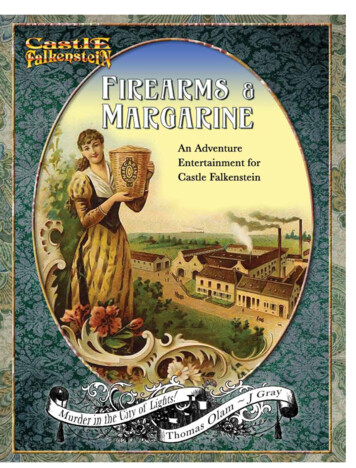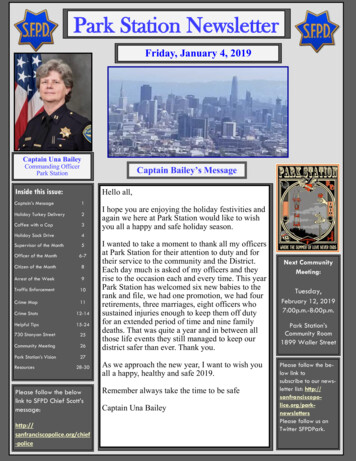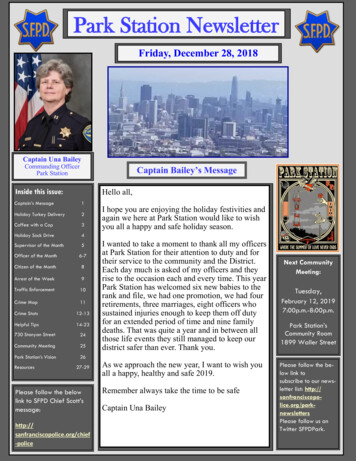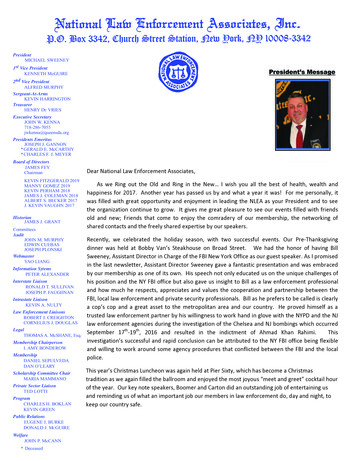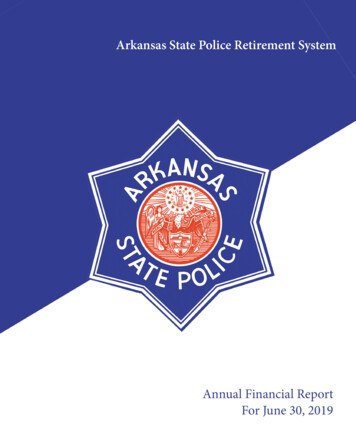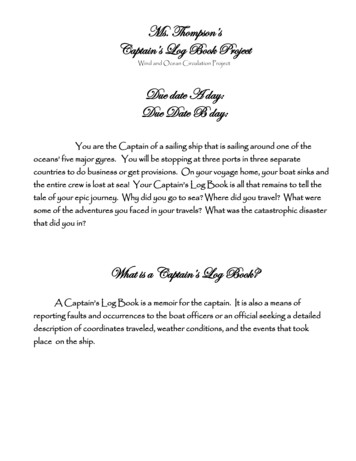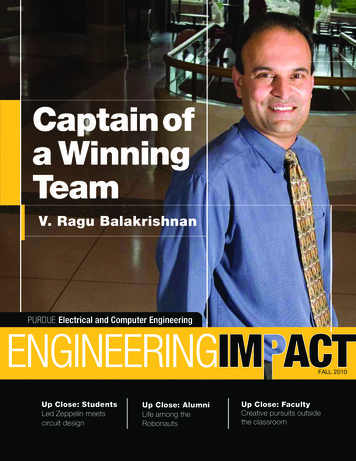
Transcription
Captain ofa WinningTeamV. Ragu BalakrishnanPURDUE Electrical and Computer EngineeringFALL 2010Up Close: StudentsLed Zeppelin meetscircuit designUp Close: AlumniLife among theRobonautsUp Close: FacultyCreative pursuits outsidethe classroom
up frontOn My MindWelcome to the fall 2010 issue of ECE Impact magazine.You will find that this issue is somewhat different fromprevious ones. We have decided to celebrate the lighter sideof our school, its faculty members, alumni and students. Didyou know that among our ranks, behind those lab coats andsuits, our school is home to musicians, sports enthusiasts,even a magician? You will read about them here. In thisissue we also celebrate the life and achievements of one ofECE’s most accomplished professors, George Cooper, whoblazed trails in the field long before cell phones or wirelessmouses were even an idea.Today, our school is at the forefront of research anddiscovery that will have a lasting impact on our country andthe world. As head of this great school, I am humbled andhonored by the opportunity to share with you my vision forour future, and what I hope to accomplish in my tenure here.I welcome your feedback and input as we move forwardtogether.V. Ragu BalakrishnanHead of Electrical and Computer EngineeringProfessor of Electrical and Computer EngineeringPurdue Engineering Impact Electrical and Computer Engineering
contentsAround ECENews from around the school3Up close: facultyMusic, sports fuel creativity8Cover storyCaptain of a winning team: ECE’s new leader, V. Ragu Balakrishnan123Up close: StudentsLed Zeppelin meets circuit design16Up close: AlumniLife among the RobonautsA little magic goes a long way1820Alumni News2010 Outstanding Electrical and Computer Engineers22Facility UpdateWang Hall site moved1224Behind the ScenesBuilding supervisor follows family tradition2516To view the College of Engineering’s Impact magazine and toconnect to the Impacts produced by our other schools, go tohttps://engineering.purdue.edu/Impact.(Cover Photo by Mark Simons)1Fall 2010
coming upSchool of Electrical and Computer EngineeringProfessor and Head. V. Ragu BalakrishnanAssociate Head . Michael MellochAssociate Head . John A. NyenhuisSenior Director of Development . . Margarita ContreniDirector of Development . Laura SloopDirector of Corporate Partners Program . Helene ElmqvistMarketing & MediaDirector of Publications . Julie RosaEditor . Barbara LeonardGraphic Designer . Carol RestContributing Writers . Russell Barnes, Joseph Fowler,Barbara Leonard, Kathy MayerCopy Editor . Dan HowellOnline . Hilary NelsonECEECE Impact magazine is produced by Purdue Marketingand Media. Find us online at https://engineering.purdue.edu/impact. Purdue is an equal access/equal opportunityuniversity, committed to the development and nurturing ofa racially, socially, and religiously diverse community.Electrical and Computer Engineering ImpactPurdue UniversityOffice of Marketing and Media507 Harrison St.West Lafayette, IN 47905-2205E-mail: peimpact@purdue.eduArticles herein may be reprinted by nonprofitorganizations without permission. Appropriate creditwould be appreciated.To make a gift to the School of Electrical andComputer Engineering, or to learn more about namingopportunities for ECE’s new building, please contact:Margarita ContreniSenior Director of Development765-496-6453mcontreni@purdue.eduLaura SloopDirector of Development765-494-9945lsloop@purdue.eduSchool of Electrical and Computer EngineeringPurdue University465 Northwestern AvenueWest Lafayette, IN 47907-20352Purdue Engineering Impact Electrical and Computer Engineering
around eceECE Student Welcome Day, August 2010ECE’s second annual Student Welcome Day in August brought students, staff and faculty together for food, fun anda chance to network with faculty, staff and fellow classmates before the school year started. The event included aperformance by the Purdue Musical Organization’s Purduettes. (Courtesy photos)3Fall 2010
around ece continuedA Job Well DonePeroulis receives prestigious teaching awardDimitrios Peroulis, associate professor of electricaland computer engineering, was one of five exceptionalteachers honored this spring with a 2010 OutstandingUndergraduate Teaching Award in memory ofCharles B. Murphy.more for his students and their success, both academicallyand in life. His instructional technique is excellent, and hisexams are challenging but fair.”Peroulis says receiving the Murphy Award hassignificantly enhanced his motivation and commitment tokeep providing students with the best Purdue experiencepossible.“Understanding complex concepts often requires achance to practice and apply problem-solving skills fromsimple cases to real-world problems,” he says.And motivation is exactly what Peroulis says his studentsneed in order to succeed.“I have been blessed by having been taught by severalexcellent teachers in my career and I know well the valuethat a good teacher can have in a student’s life,” he says.“Specifically, the motivation and encouragement he or shecan provide to a student are simply irreplaceable.”Peroulis says every student has a unique personality,learning style and needs. As a result, he finds it challengingto define a lesson that everybody needs to learn. He haspracticed a number of new instructional techniques that fita large variety of individual learningstyles. These include interactive inclass laboratories, voluntary weeklydiscussion sessions outside ofnormal class time, extended weeklyoffice hours and voluntary sub-grouplunches.Peroulis believes in a learning model that involves abalance of theory and practice.Peroulis adds that this model, when combined withhaving positive expectations from students, allows foran environment where calculated risk is acceptable andexpected.“I think a great lecture first requires a teacher with thewillingness to sacrifice a bit of his or her time and energy inorder to invest these into his or her students,” Peroulis says.“I think that willingness to adapt to different learning styles isthe second ingredient of a great lecture. I try to understandthis as early as possible and present the needed conceptsin a variety of different ways.” n Russell BarnesThese techniques have helpedPeroulis win every teaching awardavailable in his department, thehighest teaching award of theCollege of Engineering and theHKN C. Holmes MacDonaldOutstanding Teaching Award.“Peroulis is the best instructorI have ever had,” an anonymousstudent testimonial says. “I havenever met a professor who caredDimitrios Peroulis (center): “I think a great lecture first requires a teacher with thewillingness to sacrifice a bit of his or her time and energy in order to invest these intohis or her students.” (Photo by Mark Simons)4Purdue Engineering Impact Electrical and Computer Engineering
Inspiring Future EngineersCollaboration with junior high broadens ECE’s reachSeveral ECE faculty members are taking part in anoutreach program with a local junior high in hopes ofraising awareness about educational opportunities andexpanding participation of underrepresented studentsin STEM disciplines (science, technology, engineeringand mathematics).Faculty members Cheng-Kok Koh, Yung-Hsiang Lu,C.S. George Lee, Dan Jiao, Cordelia Brown, MilindKulkarni, Mithuna Thottethodi and Xiaojun Lin havejoined with more than 20 ECE students to engagestudents at Tecumseh Junior High School in Lafayette.“We have worked with about 60 eighth-graders fromthe classes of Melissa George and Scott Duttlingerfrom the Tecumseh Junior High School,” says Koh.The program is composed of two major activities.One involves Purdue students and faculty visiting theschool; the second has Tecumseh students visiting thePurdue campus and laboratories.“During these visits, we introduce the students toengineering by having them develop a computer gamecalled ‘Dance Dance Revolution’,” says Koh. “Thegoals of the program are to raise the awareness ofthe various opportunities in engineering among gradeschool students and broaden the participation level ofunderrepresented students in [STEM].”The project was developed by Michael Gasser, arecent ECE graduate, who worked under Koh and Lu’ssupervision. It began in 2009 with summer camps thatcollaborated with the Women in Engineering Programand the Minority Engineering Program. This summer,Tecumseh students developed a “Guitar Hero” videogame. n Barbara LeonardStudents at Tecumseh Junior High put engineering skills to use by building their own “Dance DanceRevolution” game. (Courtesy photo)5Fall 2010
around ece continuedA Fond FarewellGeorge Cooper’s indelible mark rememberedThe engineering world lost a considerable talent on June 8,when distinguished emeritus faculty member GeorgeCooper passed away at age 88.Cooper received his bachelor’s, master’s, and doctoraldegrees from Purdue, and upon receiving his PhD in 1949,joined the faculty of the School of Electrical Engineering. Heconcentrated his research in the areas of communicationtheory and system analysis. From 1965 to 1969, he wasassistant head for graduate study, and in 1975 he becamecoordinator of graduate study, a position he held until heretired in 1985.“While I did not have the honor and pleasure of knowingProfessor Cooper personally, my appreciation for hiscontributions to Purdue and beyond continues to grow,”says Ragu Balakrishnan, head of the School of Electricaland Computer Engineering. “Professor Cooper had 47 PhDstudents, and the impact of his work lives on through themand their achievements.”With a career that spanned over 40 years, Cooper’scontributions to Purdue’s ECE program — and the fieldat large — are legendary. He is named as inventor or coinventor on 10 patents; author or co-author of six textbooksand 75 technical papers; and a former program consultantfor the U.S. Department of Defense.Particularly prominent among his research endeavorswere significant contributions to what is today cell phonetechnology. “Professor Cooper in the 1970s, along withhis graduate students, developed new methods for spreadspectrum modulation,” says Edward Delp, the CharlesWilliam Harrison Distinguished Professor of Electrical andComputer Engineering. “These methods were the basisof modern mobile communication systems including cellphones and GPS.”Remembered as a kind, patient and compassionateman, one who epitomized integrity in work and life, hehad a tremendous impact on Purdue’s history. His formerstudents recall a riveting and insightful professor.“When I was a freshman engineering student at Purdue,Professor Cooper was the invited speaker at the W9YB6Purdue Engineering Impact Electrical and Computer Engineering“I felt very fortunate tobe a graduate student inthe last course that he taught atPurdue before he retired. He was aCooperbeloved professor,and he had a giant heart for students, andfor helping them learn and grow as people.Ted RappaportThe William and Bettye Nowlin Chair in EngineeringUniversity of Texas at Austin”Purdue amateur radio club meeting,” recalls Ted Rappaport,a former student and engineering professor at the Universityof Texas at Austin. “The year was 1978; I was new tocollege, and new to engineering. Professor Cooper’s talkabout how cellular telephones would someday provideubiquitous communications kept me on the edge ofmy seat.”Just recently, recalls Balakrishnan, “I heard from a verysuccessful alumnus who specifically credited ProfessorCooper as the one ‘most responsible for starting [him] onthe path toward developing insight into communicationstheory.’”In addition to his faculty appointment, Cooper consultedwidely on radar system analysis, automatic control systems,sonar arrays, seismic signal processing for the petroleumindustry and spread spectrum communications systems.After retirement he served as a principal scientist/engineerfor Hughes Missile Systems Co.He was a life fellow of the Institute of Electrical andElectronics Engineers and a recipient of the Purdue’sOutstanding Electrical and Computer Engineer award.n Barbara Leonard
Purdue ROV‘Competence’ Placesin InternationalCompetitionThe Purdue ROV (remotely operatedvehicle) team competed at theUniversity of Hawaii in Hilo in June andplaced fourth overall internationally.This put Purdue ahead of universitiesincluding MIT, Georgia Tech, UNC andArizona State.Students involved in the projectincluded Rob Swanson, LawrenceGoldstein, Clayton Kleppinger, SethBaklor, Clement Lan, Danielle Cliffordand Jason Gary. Their vehicle, ROVCompetence, was a major stepforward in technology and build qualityfrom the 2009 vehicle (which took fifthplace). ROV Competence was thefastest vehicle at the competition.A ROV is an underwater vehicledesigned to complete tasks thatare too dangerous, too boring, ortoo difficult for a human diver toaccomplish. ROVs are pilotedremotely with signals sent through atether and have made it as deep as35,000 feet below the sea floor.Camera on Chip WinsDesign PrizeECE students GeorgiosKarakonstantis, Vaibhav Gupta andHimanshu Markandeya won third prizein the Altera Innovate Design Contest.They developed an energy-efficientcamera on a chip able to adjust onpower and quality requirements asdemonstrated on a DE-2 FPGAboard. Mentors of the team wereprofessors Anand Raghunanthanand Kaushik Roy.For more on Gupta, see “Up Close:Students” on page 16.Graduate StudentReceives IEEE AwardGraduate student Eric Naglichwon second place in the studentpaper competition at the IEEE MTTInternational Microwave Symposium.Naglich won his prize focusing onthe ability to adaptively create deepisolation between RF systems to allowfor operating in a crowded spectrum.He determined how to cascadetunable bandpass filters and tunablebandstop filters to create nearly 100dB of isolation.The work was part of the DARPAAnalog Spectral Processors project.Co-authors were post-doc JuseopLee and professors Dimitrios Peroulisand William Chappell.Purdue Hosts RadioFrequency AllianceConferenceWhat’s needed and what’srequired for next-generation radiofrequency systems headlined theRadio Frequency Alliance Conference,“Enabling Multi-Antenna & BroadbandRF Systems,” at Purdue April 5 and 6.It drew 185 people from 35 industry,military and university organizations.Two dozen speakers led workshops,which covered reconfigurablesystems, waveform generation, activeelectronically steered antennas, radararrays of the future and other topics;32 posters from four universities werepresented.An evening of studentdemonstrations showcased Purdueprojects. “That was unique. Potentialresearch sponsors and collaboratorswere able to see the wide breadthof radio frequency research atPurdue,” says William Chappell,associate professor of electrical andcomputer engineering and conferencecoordinator.The two-year-old alliance, basedat WestGate Technology Park inCrane, Ind., focuses on bringingradio frequency technology fromresearch and academia to military andcommercial use. Its members includeCrane Naval Base, universities andnational industries.7Fall 2010
up close:facultyaround ececontinuedFaculty Recharge withMusic, Sport and CreativityBy Kathy MayerBy day, Saurabh Bagchi, Gerhard Klimeck, Mark Bell andAndrew Weiner focus, respectively, on distributed systems,nanoelectronic device modeling, signal processing andultrafast optics. Their work demands deep thinking, risk taking andstudied analysis. To recharge their energy and spark their creativity,each professor turns to activities that take him into entirelydifferent worlds.Harmonium CalmsBagchi’s MindWhen Saurabh Bagchi was in thefifth grade, he recalls, “My momwould drag me to the music schoolkicking and screaming. I had nodesire, but she persisted.” There,he learned to play the classicalmusic of famed Indian songwriterRabindranath Tagore on theharmonium, a keyboard instrumentpowered by air forced throughbellows.Today, he turns to the sameinstrument and music to relax andrefuel.“To get great ideas, you needto drown out the noise of e-mails,administrative things you need toget done, and come to a calm stateof mind,” Bagchi says. “If I sit downand concentrate on playing, my mindalmost goes to a different plane.Then my mind is better prepared forcreative thoughts.”Saurabh Bagchi (right): “To get great ideas, you need to drown out the noise ofe-mails, administrative things you need to get done, and come to a calm state of mind.”(Courtesy photo)With a repertoire of more than2,000 Tagore songs to draw from,there’s one for every mood —worship, love, patriotism and theseasons of nature, for example. “Ican start to sing a song to reflectmy mood, and start playing it outon the harmonium.”He plays alone and in a weeklymusic group. “It’s great when you8Purdue Engineering Impact Electrical and Computer Engineeringwant a moment of peace and quiet.I tell my mother occasionally that shedid well in persisting.”Like Tagore, who won a NobelPrize in Literature for his work,Bagchi enjoys writing, usually shortstories. “I find material from thetraveling I do as part of my work.That’s a gold mine of material.”
Creativity isKey for BellWhen Mark Bell came to Purduefrom California in 1989, it hadbeen several years since he’dplayed guitar, an instrument helearned at age 10. “When I wasa kid, I was interested in being astudio musician, so I learned manytypes and styles of guitar: electric,acoustic, classical, jazz, bluesand instrumental rock. In college,teaching guitar was a great way tomake extra money,” he says.In Indiana, he began playingagain. “I figured I could justify takingan hour or two a day to practicebecause most people watch moreTV than that, and I don’t own a TV,”he says.He’s stayed with it, and for aboutfive years performed with a group,New Acoustic Quintet. “The ideawas to move jazz onto bluegrassinstruments. We tried it out atIndiana Fiddlers’ Gathering and otherfestivals, and it was well received.”Today, he most enjoys playing jazzand classical guitar, and composing.“Creativity is key,” he says. “Inengineering and scientific research, ifyou’re not creative, you’re rehashingthe same old things, which ispointless. The same is true ofimprovisational music.”Music takes discipline. “Youhave to focus and put in the effort.It’s like research. Neither comeseasily.”Recently he combined the twoin work with Seymour Duncan,a company that makes guitarpickups, which translate strings’mechanical motion into electricalsignals. “I found a couple of goodECE students who are passionateguitarists to work on the project,and it’s worked out well.”Mark Bell: “Creativity is key in engineering and scientific research, if you’re not creative, you’re rehashing the same old things.”(Courtesy photo)9Fall 2010
faculty continuedGerhard Klimeck: “Skiing and soccer get me away from work. After I focus on one of these, it lets me think afresh.” (Courtesy photo)Ski Slopes, Soccer Energize KlimeckGive Gerhard Klimeck the steep,rough terrain of a double blackdiamond ski slope, and his mindis immediately cleared of all butthe task at hand. “It takes extremeconcentration and exertion,” he says.“I can completely exhaust myself onchallenging runs.” When he can’t ski,soccer fills a similar bill.What both translate into forKlimeck, director of the Network forComputational Nanotechnology, isa clear head, he says. “Skiing andsoccer get me away from work.After I focus on one of these, it let’sme think afresh.”exhilarating things, and I always likedsports and being outside.”Klimeck takes to anything thatrequires physical exertion, he says.Some of his favorite skiing spotsinclude La Villa in Dolomites,Italy; and Aspen Highlands andSteamboat Springs, in Colorado.“I love the great outdoors. Gettingaway helps. Seeing nature, gettingdifferent perspectives, gettingdistance — all those certainly helpmy creativity,” he says.He learned to ski at age 15 onvacation in the Alps. “From day oneI knew it would be fun, becauseI like speeds. I like dangerous,10Purdue Engineering Impact Electrical and Computer EngineeringNot all of his skiing or sport isdevil-may-care these days, however.He’s taken his 5-year-old son on agreen run and to the soccer field,and soon will introduce his 3-yearold daughter to the gentler slopesand fields.
Aikido ShiftsWeiner’s FocusOf aikido’s many benefits, two inparticular influence the work ofAndrew Weiner, the Scifres FamilyDistinguished Professor of Electricaland Computer Engineering.The first is the physical aspect.“You can work more effectively ifyou are healthy and feeling good,”he says. The other is the mutualbenefit and respect that permeatethe martial art. “The respect aspectis very important in our professionallives, too.”Weiner first took up the rigorous,noncompetitive Japanese martialart as a seventh-grader, steppedaway a while, then returned as anadult. Today, he’s chief instructorand advisor for the Purdue AikidoClub, and he’s achieved the nidanrank, a second-degree black belt.“Discipline is one of the positivethings about it, and it also has itsspontaneous aspects,” Weinersays. “On the mat, you sometimesrun into situations different thanwhat you have precisely trained for.”Aikido demands focus. “Youneed to forget what else you weredoing in the day, were troubled byor excited about working on, andinstead focus on the activity athand,” he says. “It’s vigorous. Andyou must accept that much of it ishard work. It’s not an art where youget instant gratification.”The self-discipline aikido imposeskeeps him working at it. “And that’simportant in research, too. Part ofresearch is hard work, to be topnotch and leading the way. Learninghow to work hard and keep pushingis important.”Andrew Weiner (right): “The respect aspect (of aikido) is very important in ourprofessional lives, too.” (Courtesy photo)11Fall 2010
ECECaptain of aWinning TeamV. Ragu Balakrishnanby Kathy Mayer12Purdue Engineering Impact Electrical and Computer Engineering
TEAMLeadership in education, higherrankings, increased research inareas of global impact, and a morediverse school are among the topquests for Ragu Balakrishnan, thenew head of the School of Electricaland Computer Engineering.Up at 5 a.m., responding to e-mails from home, then bicycling — rain orshine — to the office by 8 a.m. set the pace for Balakrishnan’s invigoratingday guiding the School of Electrical and Computer Engineering, a job heheld as interim head for 15 months before being named head in May.“Coming to work is not work. It’s a pleasure,” he says. He oversees — allby consensus — a school of 81 faculty, 40 staff, 880 undergraduates and660 graduate students.“I don’t tell people to do what I want. As an administrator, I am servingand leading through service,” Balakrishnan says. “Everybody is important.Everybody does something essential to our success.” continued on next page13Fall 2010
Captain of a Winning Team continuedA Passion forPuzzlesPuzzling out solutions to crosswords is apastime and passion for Ragu Balakrishnan.As interim head, he launched a welcome day for newstudents. He also hosts annual faculty retreats to assess “wherewe are and what we need to do to enhance our reputation. Weidentify core values, discuss priorities and talk things through.We are all part of a joint mission.”That mission has been fine-tuned into a new strategic planwith hefty goals that include leadership and excellence ineducation, field-defining research and a positive impact onsociety.Raising Rankings, Research OpportunitiesWithin a few years, Balakrishnan wants ECE to be rankedin the top five schools, up from the top ten. “I want us to bementioned in the first breath,” he says. “It’s not a popularitycontest, but will be based on true metrics — our impact.”He’s also eyeing giant strides in research. “We’ve hadenormous growth in faculty and our PhD programs. We nowhave a critical mass and can go after more problems of globalimportance,” he says. “We can leverage this growth for anexplosion in productivity.”While there will always be opportunities for faculty to conductresearch individually or in small teams, Balakrishnan foreseesmore multidisciplinary efforts similar to three projects involvingECE faculty. These are the 105 million National ScienceFoundation (NSF) grant for earthquake studies at Purdue’sNEEScomm Center, the 18 million NSF grant for the Networkfor Computational Nanotechnology, and the 15 millionHomeland Security grant for Visual Analytics for Command,Control and Interoperability Environments, dubbed VACCINE.With that comes the challenge of boosting graduate studentfunding. “We have a lot of mouths to feed, so that is a priority.”Balakrishnan is committed to making the school more diverseby increasing the number of underrepresented minorities andwomen, and says that curriculum changes will increase timefor team projects, problem solving and interaction. His desire isthat students leave with a lifelong appreciation for Purdue, forlearning, and with “skills that make them complete people.”14Purdue Engineering Impact Electrical and Computer Engineering“I work the New York Times crosswordpuzzle every day. I also love cryptic crosswords,where the true definition and an oblique, orcryptic, definition come into play. Some crypticcrosswords can take a few days to solve,” hesays. “It’s fun to let your mind dwell on a clue,often subconsciously. It’s a great feeling whenthe answer pops out, seemingly out of nowhere.”These diversions are essential and “almostaddictive,” he says. “I’ve learned that being ahead involves solving problems and makingdecisions, large and small, and such activitiesparadoxically seem to provide rest for the mind.”For the curious, Balakrishnan offers thiscryptic clue, appropriate for Purdue alumni:“Cheer alma mater; I ‘up-laud’ her freely(4, 6).”[See Page 15 for the answer.]
“We now have a critical mass and can go aftermore problems of global importance. Wecan leverage this growth for an explosion inproductivity.— Ragu Balakrishnan”As the leading diplomat for the school, Balakrishnan staysin touch with the school’s large community of alumni andfriends. He considers spending time with alumni a “hiddenpleasure” of the job, and has found that “the Purdue ECEname opens access. It’s both exhilarating and humbling tocarry the weight of Purdue University.”He earned a master’s degree in statistics and doctoratein electrical engineering from Stanford in 1992, did postdoctoral work, then joined the Purdue faculty in 1994.His research interests have included applying numericaltechniques, especially those based on convex optimization,in engineering applications.Well Prepared to LeadGrowing up in India, Balakrishnan says the overridingmessage was to be outstanding academically. “A hugepremium is placed on academic success. I paid attention toit and did fairly well,” he says. So well, in fact, that when heearned his undergraduate degree in 1985 from the IndianInstitute of Technology, he also received the prestigiousPresident of India Gold Medal. Getting accepted to theinstitute was itself a feat; he competed against 100,000students for the 2,000 entrance spots.His goal 16 years ago was to “put my head down andwork hard to be a successful faculty member — I hadno interest to be in administration.” When offered, he didaccept administrative roles, though, finding them “a niceway to contribute something to the department.”Nicknamed “Ragu” by his mother, “a common name inIndia,” he says, he shares with her a love of people. Hisfather, who died about a decade ago, was a chemistrygraduate who managed a paper company. Balakrishnanhas one sibling, a sister who lives in England and works incomputer systems.Of his Purdue and school posts as director of graduateadmissions, associate head for education, associate deanof engineering for research, and now ECE head, he says,“I feel like I’ve grown up here.” nBalakrishnan is married to Ann Rundell, who is on thefaculty at the Weldon School of Biomedical Engineering.The couple has a son, Ashwin, age 5.In 1985, Ragu left India for graduate study at StanfordUniversity. He arrived on a sunny California day. “It was 60degrees, but it was the coldest I’d ever been in my life,” herecalls.”Puzzle answer: Hail Purdue.“It’s fun to let your minddwell on a clue, oftensubconsciously. It’s a greatfeeling when the answerpops out.15Fall 2010
up close: studentsLed Zeppelin meets Circuit DesignA doctoral student’s guitar affairThere are stereotypes aboutengineering students. Thoseguys and gals are no fun, allthey want to do is go overtables of blueprints and listen to lectures on the individual components ofa device which itself will be the focusof a later lecture (which they can’twait to attend).Vaibhav Gupta breaks down thosestereotypes with a loud riff from hiselectric guitar. Gupta expressedhis love of electric soft rock in the“Engineering’s Got Talent!” contesthosted by Engineering PresidentsCouncil last spring. He performedthree songs, the traditional guitarsong “Spanish Romance,” “Wake MeUp When September Ends” by GreenDay, and the rock classic “Stairwayto Heaven” by Led Zeppelin. It wasa big moment for him; Gupta usuallyjust plays by himself or for his friends.He won a participation certificate forhis act.“I did fine and I got lots ofappreciation from the audience,” saysGupta. He’s been playing since hisundergraduate days and primarilyplays in the soft rock genre.“The thrill comes from playing asong and hearing your own version,it’s a sense of accomplishment whenyou learn a song,” he says. “It makesme happy.”Gupta enjoys the quiet of the WestLafayette area, “I
ECE Impact magazine is produced by Purdue Marketing and Media. Find us online at https://engineering.purdue. edu/impact. Purdue is an equal access/equal opportunity university, committed to the development and nurturing of a racially, socially, and religiously diverse community. Electrical and Computer Engineering Impact Purdue University


